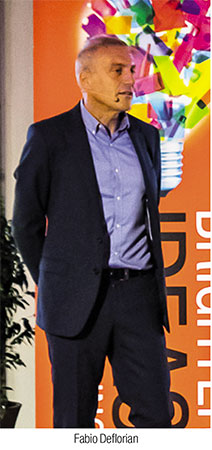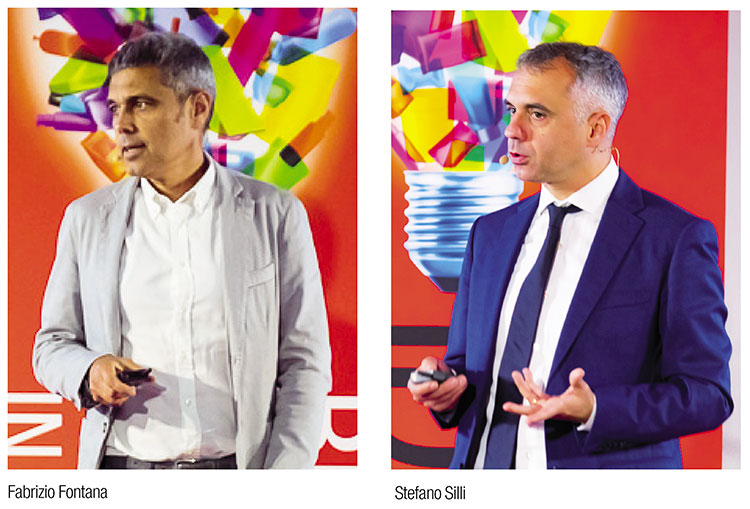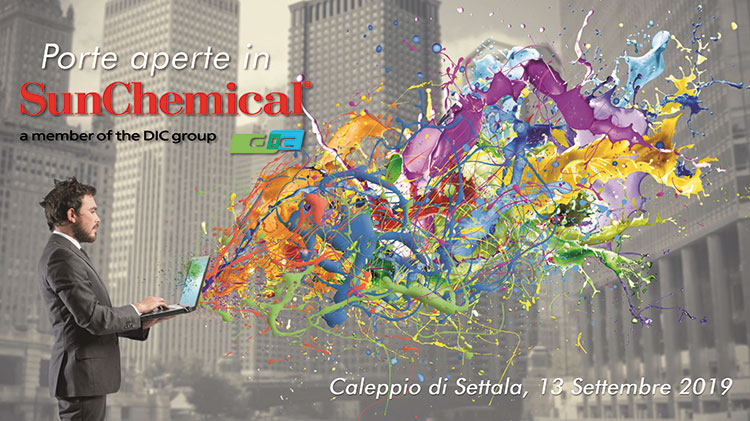Doors open... to the adventure (but always with maximum safety)
Caleppio di Settala (MI), 13 September 2019. As punctual as ever Sun Chemical is back again this year to bring together a group of about 50 printing and converting faithfuls, in the name of the printing inks it produces, renewing a liturgy in which moments of encounter and exchange are mixed with occasions for updates and convivial events. This time, however, derogating from and innovating with respect to a story that over the years has unfolded between social/info events - from the cooking school to on-site “bubbly” tasting, from sailing regattas to vintage car rallies, to truffle hunting - the present encounter offered a complete reversal of perspectives... with the final coup de théâtre. Masterly. Stefano Lavorini

Already the title “Doors open at Sun Chemical” headed drew the attention and the commitment of those present.
Opening the proceedings the CEO of Sun Chemical Group SpA, Fabio Deflorian, in a brief talk, bestowed with logic given though with a powerful humoral rendering, concentrated on the very recent definitive agreement, according to which the parent company DIC Corporation will by the fourth quarter of 2020 acquire BASF’s global pigment business, known as BASF Colors & Effects (BCE).
 Aboveall safety
Aboveall safety
Fabrizio Fontana, Operations Director Italy, in addition to providing attendees with all the useful information in anticipation of the visit to the plants, presented a clear example of the production processes of printing inks (1) and traced an overview of the two Caleppio production sites:
- Caleppio 1, which covers an area of 41 thousand m2, dedicated to the production of offset inks and water-based inks (about 36 thousand t/year), home to the offset ink laboratory and the color laboratory for all types of inks;
- Caleppio 2, which covers an area of 48 thousand m2, specialized in the production of solvent-based liquid inks, and equipped with its own research and development laboratory. It should be noted that Caleppio 2 is also divided into two areas, Branch and Mother Plant, dedicated respectively to the production of inks for customers (about 33 thousand t/year) and to the production of colored concentrated bases, which are distributed to all the subsidiaries of the group in Europe and beyond (about 10.6 thousand t/year).
This site comes under the Seveso legislation (sites at risk of major accidents) and it goes without saying that the issue of safety is a priority for everyone. As evidence over the last year, almost 4,700 hours of training were given to workers on the subject.
Sun Chemical also has an integrated quality/environment/safety management system and is ISO 9001 certified for quality, ISO 14001 for the environment, OHSAS 18001 for safety and ISO 22000 for food safety. All things that the participants could see at first hand, during a guided tour of over 2 hours, enriched with explanations and details of every kind and fact, provided with inexorable competence by the women and men of Sun Chemical.

Product safety & sustainability
Stefano Silli, Product Safety Coordinator Italy, then introduced the two macro-topics of the day.
Regarding product safety, Silli illustrated the organization of Sun Chemical, its certifications, the meaning of “ink” and “support”, which rules and regulations impact these products, ending with some current issues: inks and varnishes for the printing of packaging intended for heat treatments but also the end-of-life of the materials, hence their compostability and recyclability.
About this last theme, he did well to recall some basic concepts, emphasizing the different meaning of the two terms. «Compost is a stable biological fertilizer used in agriculture, which derives from the decomposition of materials in aerobic and controlled conditions of temperature and humidity. To be compostable a material must obviously have specific characteristics, in terms of chemical composition, ecotoxicity, biodegradability, fragmentation.
In other words:
- there must be no heavy metals, halogens, etc .;
- it must not have negative effects on plant growth;
- must biodegrade at least 90% in six months (and the sum of the non-biodegradable components must be less than 5%);
- within 3 months at least, 90% of the material must consist of residues smaller than two millimetres.
From the above, it is clear that biodegradability is only one aspect of compostability and, importantly, the two concepts do not coincide and have different meaning.
And if a compostable material is always biodegradable, the reverse is not always true. In fact, biodegradability is the conversion into simple molecules (such as water, carbon dioxide, methane) and in this sense, it is true that all materials are biodegradable: however, the difference lies in the time required for the process to be completed. In short, if a material takes thousands of years to deteriorate, it is not useful for the community, for industry and for the sector in which we operate».
Silli then moved on to discussing sustainability, explaining Sun Chemical’s mission in this regard and, therefore, the operational criteria that define it (laws, Key Performance Indicators - KPI) up to reaching some qualifying topics, such as the current tendency to use, for printing inks, raw materials from vegetable sources, replacing those derived from fossil sources. Not just fine words, because how much of an ink is biologically derived can be measured accurately using the carbon 14 technique. Moreover, already today new eco-compatible solutions are available, such as vegetable-based offset inks, used essentially in the paper industry, which have a fossil-based content of 23% and a bio-derived base of 77%.
The way has been traced out and there is no going back, at least as far as Sun Chemical is concerned.
 A 3-year-long thrill
A 3-year-long thrill
Alongside the much appreciated lunch, which sealed the intense “Open Doors” morning, the enigmatic Fiorenza Raggi (Sun Chemical’s marketing manager) finally lowered the ace of spades, revealing the meaning of the anxiogenic title “pure adrenaline”, which appeared in the invitation received by the participants and which no one had managed to discern.
With a soft voice, and not without a touch of amused irony, she announced that the event held in Caleppio was only the first of a series of associated events, to be completed 2021.
Stunning the guests, she illustrated the stages of a sort of skills and courage elimination race, in which only the best - obviously not from a professional point of view - are destined to be recognized as winners. Perhaps with the intent on showing that to be a printer or converter in Italy it is not enough to know how to do your job well, you also have to have some endowments of the superhero...
Below, therefore, the stages of the road that leads... to the Olympus of Sun Chemical.
First stage, 5 and 6 February 2020
The representative of each of the 50 companies present will participate in the course and the piloting competition on ice, “Ice Driving School”, organized by the Toyota Driving Academy on the Champoluc Driving Park (AO), as explained by the head of the Tobia Cavallini school.
Second stage, October 2020
The top 18 finishers of the February event will enter the “Ferrari Challenger”, that is a track race with Ferrari Challenge racing cars: an exclusive experience that guests will have in complete safety, supported by professional racing drivers. .
Third and final stage, May 2021
The top 9 finishers in the Ferrari Challenge will fly high, given that they will be able to experience a day with a group of pilots from the aerobatic team, learn the secrets of flight, equip themselves with overalls and parachutes and get on YAK 50 and 52 military-derived training aircraft, enjoying the extreme thrill of circling in the skies. Obviously, the “Flying Experience” will be as highly engaging as it is safe, as Franco Baldani of the Yak Italia team, Italy’s only civil aerobatic (acrobatics in training) team stated, wishing to reassure the participants.
Well, if you don’t believe it, just try it ...
Valeo si vales [If it’s good for you it’s good for me]

(1) IN BRIEF. How an ink is produced. It starts with resins which are dispersed in the solvent and in this way the varnish is obtained. Subsequently, the pigment is dispersed in the varnish (pre-dispersion and refining) until a concentrated paste, or the colored intermediate is produced. Lastly, the concentrated pastes and technological varnishes - in turn composed of resins, solvents and additives - are mixed together to form the finished inks.



















